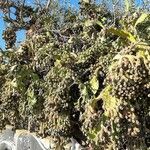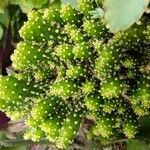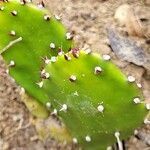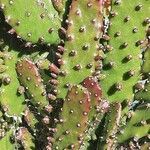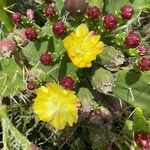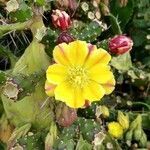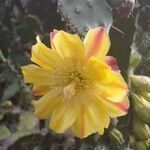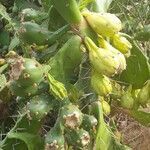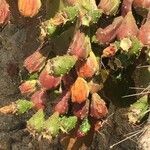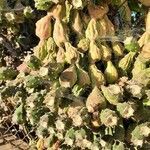Erect shrub usually 2–3 m high, or occasionally arborescent to 6 m high, to 4 m wide, older plants with short well-developed trunk to 1 m high and 30 cm diam. near base. Stem segments firmly attached, narrowly obovate, obovate or oblong or lanceolate, compressed, not tuberculate, 10–45 cm long, 6–15 cm wide, 5–10 mm thick, tapered towards the base, with sinuate margin, smooth, bright green when young green, glossy, glabrous, often drooping in older plants. Areoles 10–25 per stem segment face, typically 20–40 (–60) mm apart, circular, 3–4 mm wide, with wool whitish. Leaves succulent, terete, conical, 2–6 mm long, caducous. Spines mostly 1 or 2 per areole, on most areoles or mainly confined to the upper half of stem segment, unequal, spreading in various directions, 25–50 mm long, 0.7–1.5 mm wide at base, (up to 40 spines per areole and to 10 cm long on trunk), rigid, minutely barbed, subterete in cross-section, straight, white to brown with yellow or red markings (rarely spines all reddish). Glochids 2–3 mm long, yellowish to reddish brown. Flowers 30–95 mm diam.; outer tepals with red centres and yellow margins, succulent, the largest obovate or broadly cuneate, up to 25 mm long, the apex obtuse, or emarginate, entire; inner tepals yellow, the outer series tinged red, widely spreading, cuneate to oblanceolate-obovate, 25–40 mm long, 12–40 mm wide, the apex acute and nearly entire; staminal filaments pale yellow or creamish, green near base, anthers pale yellow; style white to pale creamish, stigma lobes pale yellow to pale creamish; pericarpel (at anthesis) not tuberculate, areoles distant, spineless. Fruit solitary or usually proliferous, forming chains of up to 10 fruits, long-persistent, obovoid to pyriform, 40–90 (–150) mm long, 40–50 mm diam., not tuberculate, umbilicus shallow, areoles distant, spineless, the fruit maturing and reddish purple, greenish near base, or green with red-purple shades, succulent and juicy, edible, often not maturing. Seeds 3.5–4 mm long, pale brown.
More
Shrubs or treelike, 1.3-4 m tall. Trunk (when present) terete. Larger, terminal joints glossy green, obovate, narrowly so, obovate-oblong, oblong, or oblanceolate, 10-30 × 7.5-12.5 cm, thin, narrowed basally, margin undulate toward apex. Areoles 3-5 mm in diam. Spines sparse on joint 1 or 2(or 3) per areole, but on main trunk to 12 per areole, erect or spreading, grayish, dark brown tipped, acicular, 1-7.5 cm; glochids brownish, 2-3 mm. Leaves conic, 2-4 mm, deciduous. Flowers 5-7.5 cm in diam. Sepaloids with red midrib and yellow margin, obovate or broadly ovate, 0.8-2.5 × 0.8-1.5 cm, apex rounded or emarginate. Petaloids spreading, yellow to orange, or obovate to oblong-obovate, 2.3-4 × 1.2-3 cm, margin subentire, apex rounded, truncate, or muricate. Filaments greenish, ca. 12 mm; anthers pale yellow, ca. 1 mm. Style greenish, 1.2-2 cm; stigmas 6-10, cream, 4.5-6 mm. Fruit reddish purple, obovoid, 5-7.5 × 4-5 cm, umbilicus slightly depressed. Seeds light tan, irregularly elliptic, ca. 4 × 3 mm. Fl. Apr-Aug.
A cactus. It is a spiny leafless shrub. It grows 1-3 m tall. It is treelike with several branches. The stems are succulent. There are oblong jointed segments. These are covered with needle-like spines. They are shiny green. They are about 10-30 cm long. The flowers occur singly at the base of the spines near the end of the plant. The flowers are golden yellow. The stamen filaments are green. The fruit are reddish-purple. They are pear shaped and 7 cm long.

